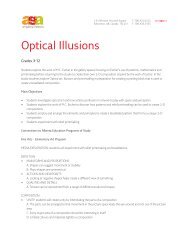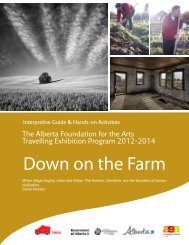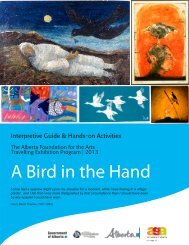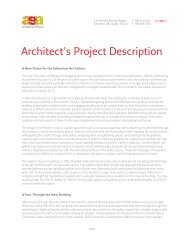Urban Animals - Art Gallery of Alberta
Urban Animals - Art Gallery of Alberta
Urban Animals - Art Gallery of Alberta
Create successful ePaper yourself
Turn your PDF publications into a flip-book with our unique Google optimized e-Paper software.
The <strong>Alberta</strong> Foundation for the <strong>Art</strong>s Travelling Exhibition Program<br />
Modernism according to Clement Greenberg<br />
Clement Greenberg (1909-1994) was an influential American art critic closely associated with<br />
Modern art in the United States and Canada. He helped to articulate a concept <strong>of</strong> medium<br />
specificity and championed abstraction in the visual arts. In 1940, in an influential piece in<br />
Partisan Review, Greenberg argued that the value <strong>of</strong> art was located in its form, which is<br />
inseparable from its content. In his first essay on modernism, written in 1960, Greenberg gave<br />
what has been described as what may be the most elegant definition <strong>of</strong> modernism in<br />
existence. In the essay Greenberg defined modernism as:<br />
...the use <strong>of</strong> characteristic methods <strong>of</strong> a discipline to criticize the discipline itself, not in order to<br />
subvert it but in order to entrench it more firmly in its area <strong>of</strong> competence.<br />
According to Greenberg’s essay, all the arts, in order to not be devalued in society, had to<br />
demonstrate that the kind <strong>of</strong> experience they provided was valuable in their own right and not<br />
to be obtained from any other kind <strong>of</strong> activity. As a result, what had to be exhibited was not only<br />
that which was unique and irreducible in art in general, but also that which was unique and<br />
irreducible in each particular art.<br />
In this process it quickly emerged that the unique and proper area <strong>of</strong> competence <strong>of</strong><br />
each art coincided with all that was unique in the nature <strong>of</strong> its medium. In criticizing itself,<br />
it became art’s task to eliminate from the specific effects <strong>of</strong> each art any and every effect that<br />
might be borrowed from or by the medium <strong>of</strong> any other art. Through this each art would be<br />
rendered “pure” and in this “purity” it would find the guarantee <strong>of</strong> its standards <strong>of</strong> quality.<br />
In painting, the limitations that constitute the medium <strong>of</strong> painting - the flat surface, the shape <strong>of</strong><br />
the support, the properties <strong>of</strong> the pigment - were traditionally treated as negative factors that<br />
could be acknowledged only implicitly or indirectly. In an Old Master painting, for example, one<br />
tends to see what is in the painting before one sees the picture - the paint itself, the works<br />
format - itself. Traditionally artists attempted to create an illusion <strong>of</strong> space in depth that the<br />
viewer could imagine oneself walking into. Modernism in painting reversed this. Through<br />
stressing the flatness <strong>of</strong> the surface, the flatness <strong>of</strong> the picture plane being the only<br />
thing unique and exclusive to pictorial art, Modernist artists created a situation where<br />
the viewer sees a Modernist picture as a picture first. In a modernist painting, the illusion<br />
created can only be seen into and can only be traveled through, literally or figuratively, with the<br />
eye. In other words, the painting is an object itself, not merely a vehicle for a story or an<br />
illusion.<br />
Modernism in the visual arts is closely linked to the concept <strong>of</strong> formalism. Formalism is the<br />
concept that a work’s artistic value is entirely determined by its form - the way it is made, its<br />
purely visual aspects, and its medium. Formalism emphasizes compositional elements such<br />
as colour, line, shape and texture rather than realism, context and content. In visual art,<br />
formalism posits that everything necessary to comprehending a work <strong>of</strong> art is contained<br />
within the work <strong>of</strong> art. In formalist theory, the focus is on the aesthetic experience gained from<br />
the piece.<br />
AFA Travelling Exhibition Program, Edmonton, AB. Ph: 780.428.3830 Fax: 780.421.0479<br />
youraga.ca

















